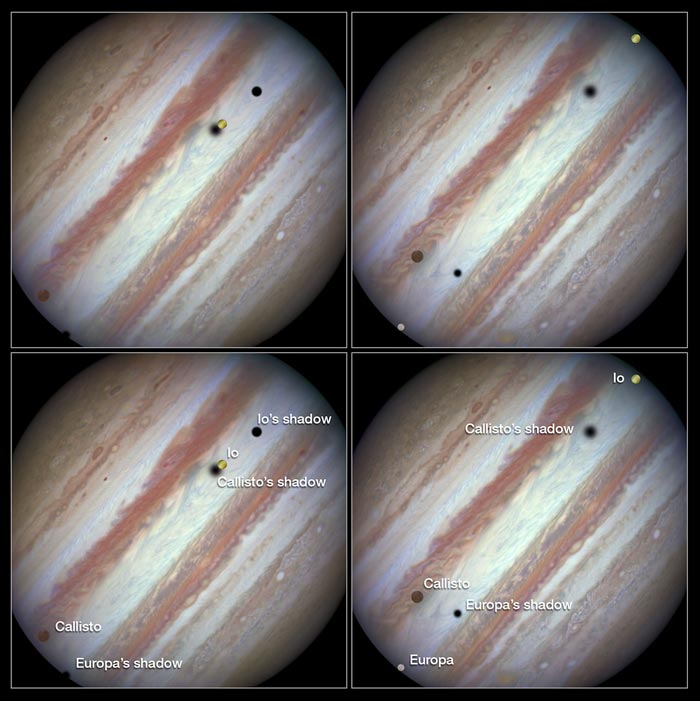March of the moons

Image credit: NASA, ESA, Hubble Heritage Team
These new NASA/ESA Hubble Space Telescope images capture a rare occurrence as three of Jupiter’s largest moons parade across the giant gas planet’s banded face. Hubble took a string of images of the event which show the three satellites — Europa, Callisto and Io — in action.
There are four Galilean satellites — named after the 17th century scientist Galileo Galilei who discovered them [1]. They complete orbits around Jupiter ranging from two to seventeen days in duration. The moons can commonly be seen transiting the face of Jupiter and casting shadows onto its layers of cloud. However, seeing three of them transiting the face of Jupiter at the same time is rare, occurring only once or twice a decade.
The image on the left shows the Hubble observation at the beginning of the event. On the left is the moon Callisto and on the right, Io. The shadows from Callisto, Io and Europa are strung out from left to right. Europa itself cannot be seen in the image.
The image on the right shows the end of the event, just over 40 minutes later. Europa has entered the frame at lower left with slower-moving Callisto above and to the right of it. Meanwhile Io — which orbits significantly closer to Jupiter and so moves much more quickly — is approaching the eastern limb of the planet. Whilst Callisto’s shadow seems hardly to have moved, Io’s has set over the planet’s eastern edge and Europa’s has risen further in the west. The event is also shown from start to finish in a video.
Missing from this sequence is the Galilean moon Ganymede which was outside Hubble’s field of view.
The moons of Jupiter have very distinctive colours. The smooth icy surface of Europa is yellow-white, the volcanic sulphur surface of Io is orange and the surface of Callisto, which is one of the oldest and most cratered surfaces known in the Solar System, is a brownish colour.
The images were taken with Hubble’s Wide Field Camera 3 in visible light on 23 January 2015. Whilst Hubble captures these moons in great clarity they can also be seen with a small telescope or even a decent pair of binoculars. Why not try it at home?
Notes
[1] These were among the first observations ever made using a telescope. They revolutionised our understanding of the Universe, and finally laid to rest the theory that the Earth is the centre of the Solar System.
Notes for editors
The Hubble Space Telescope is a project of international cooperation between ESA and NASA.
Contacts
Georgia Bladon
ESA/Hubble Public Information Officer
Garching bei München, Germany
Tel: +44 7816291261
Email: gbladon@partner.eso.org
Media Contact
More Information:
http://www.spacetelescope.org/news/heic1504/All latest news from the category: Physics and Astronomy
This area deals with the fundamental laws and building blocks of nature and how they interact, the properties and the behavior of matter, and research into space and time and their structures.
innovations-report provides in-depth reports and articles on subjects such as astrophysics, laser technologies, nuclear, quantum, particle and solid-state physics, nanotechnologies, planetary research and findings (Mars, Venus) and developments related to the Hubble Telescope.
Newest articles

Solving the riddle of the sphingolipids in coronary artery disease
Weill Cornell Medicine investigators have uncovered a way to unleash in blood vessels the protective effects of a type of fat-related molecule known as a sphingolipid, suggesting a promising new…

Rocks with the oldest evidence yet of Earth’s magnetic field
The 3.7 billion-year-old rocks may extend the magnetic field’s age by 200 million years. Geologists at MIT and Oxford University have uncovered ancient rocks in Greenland that bear the oldest…

Decisive breakthrough for battery production
Storing and utilising energy with innovative sulphur-based cathodes. HU research team develops foundations for sustainable battery technology Electric vehicles and portable electronic devices such as laptops and mobile phones are…





















